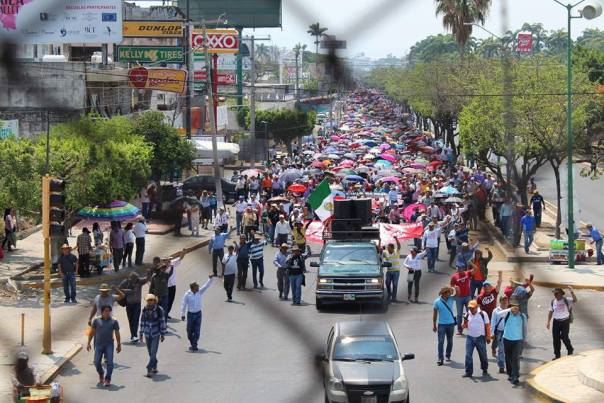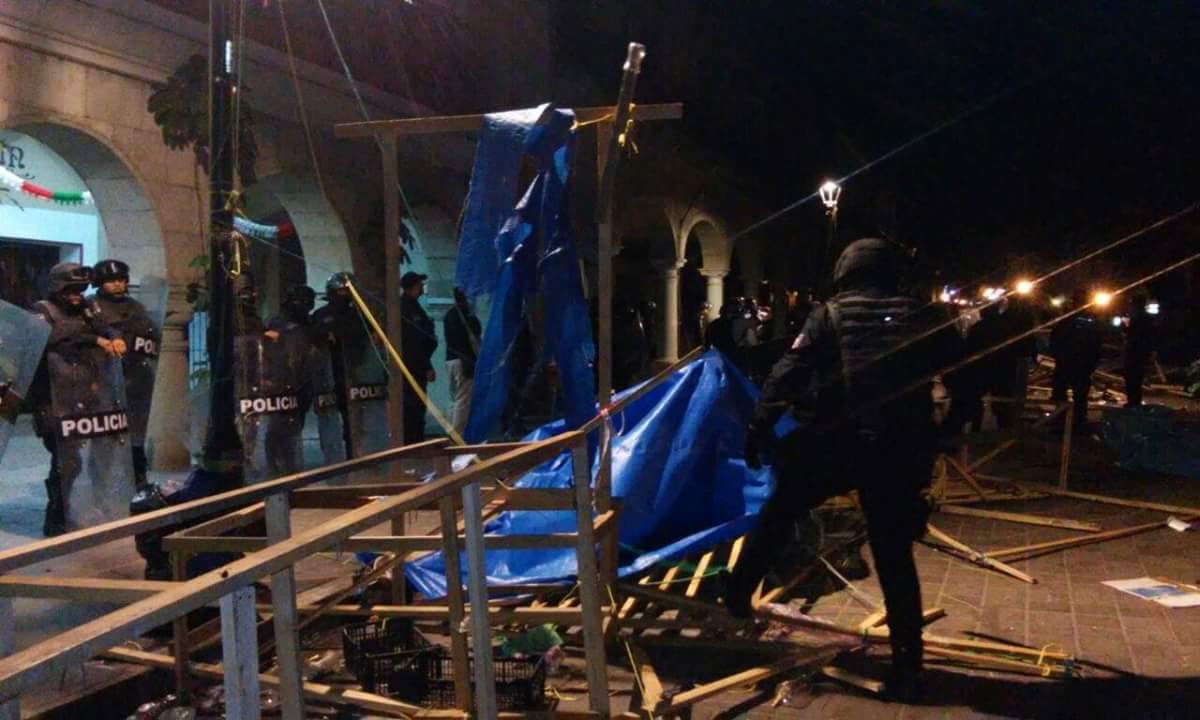Filed under: Editorials, Insumisión, Mexico

Originally posted to It’s Going Down
By Scott Campbell
As the teachers’ strike in Mexico continued into the start of the school year, the last Insumisión column noted the tense situation developing, particularly in Oaxaca, with the break down of negotiations between the teachers union and the government and the arrival of hundreds of more federal forces to the state. While there was a show of force by the Oaxaca state government before dawn on Sunday, September 11, the feared widespread repression did not occur. Instead, the struggle against the neoliberal educational reform and structural reforms in general has lost some of its consistency and coherency as various state sections of the National Coordinator of Education Workers (CNTE) take different approaches following the start of the school year.
Initially, the CNTE seemed to be holding to its stance that the strike would continue until the educational reform was repealed. When classes were to start on August 22, teachers in Oaxaca, Chiapas, Guerrero, Michoacán and parts of Mexico City remained on strike. Instead of classrooms opening, mass marches and blockades inaugurated the school year in Chiapas and Oaxaca. Teachers installed 25 highway blockades in Oaxaca that they held for 48 hours, except in Nochixtlán, which lasted for four days. In Chiapas, teachers blockaded four entry points into the state capital of Tuxtla Gutiérrez for two days, not allowing trucks belonging to transnational corporations to pass.
After the first week of school came and went with the strike still on, the government retaliated by announcing it will begin fining and firing teachers. 43,231 teachers were issued fines, most from Chiapas, while 1,225 were slated to be fired in Oaxaca, 570 in Chiapas, and 80 in Michoacán. Despite the legal and military machinations unleashed against the union, the CNTE still appeared firm. A Section 22 assembly in Oaxaca on August 26 agreed that the strike would continue. They threatened that if the government didn’t negotiate seriously, “activities will be carried out that will generate country-wide ingovernability.” They pledged to put permanent highway blockades in place on August 29 and to not allow governor-elect Alejandro Murat to take office on December 1.
Also on August 26, Public Education Minister Aurelio Nuño, who was launching a nationwide speaking tour to promote the educational reform, was heckled by hundreds of teachers when he showed up to speak in Ecatepec, State of Mexico. The relentless shouting of “OUT!” by teachers in a state long considered to be loyal to the mainstream teachers union and thus to the state, led Nuño to cancel his inaugural speech.
https://youtu.be/qgncWN6UqhE
The strike continued into the second week of the school year. In Chiapas, teachers shut down more than 20 Oxxo convenience stores in Tuxtla Gutiérrez on August 29. The following day, the civil resistance organization and adherent to the Sixth Declaration, Light and Power of the People, with a presence in 60 municipalities in Chiapas, urged the teachers to continue their struggle and called for a national long-term action plan to bring down the government: “The reforms will only fall when this system of government falls. So we call on all our people to unite, to organize and to fight together, to control territory and exercise our power rooted in the people. Elections are a farce, we urge you to not allow a single political party into our territories.” The state responded to this steadfastness by sending hundreds more federal police to Chiapas as August came to a close.
Arriban a aeropuerto de Tuxtla Gutierrez, Chiapas cientos de efectivos de @PoliciaFedMx con armas largas. pic.twitter.com/uHemH8uPnr
— Alexis Añorve (@appo_stol) August 31, 2016
Then all of the sudden, Section 22 announced on September 3 it would be returning to classes on September 7. It was said this decision was made during the state assembly, yet no record of it is present in the publicly available notes of that meeting. Rather, that summary says they agreed that the national strike would continue. In a subsequent announcement, Section 22 stated that the return to classes does not mean defeat, but is rather a reorganizational moment in the struggle. It said that a national CNTE assembly on September 6 would define the new path of the movement, however, as of this writing, the results of that assembly have not yet been made public.
Meanwhile, Sections 7 and 40 in Chiapas met to decide whether or not to return to classes. The federal government verbally offered for the educational reform to be de facto suspended in Chiapas through the end of Enrique Peña Nieto’s term in 2018 if the teachers returned to class. Instead, with the continued support of parents and civil society organizations, the teachers shut down three major shopping centers in Tuxtla Gutiérrez and in an assembly on September 9 decided to continue the strike.
Section 22 in Oaxaca was given no such offer. Rather, the return to classes seemed to be a bid to get the government to let them back to the negotiating table, though all negotiations thus far have been fruitless. At present, the state has refused to return to negotiations and said that if they do happen in the future, repeal of the educational reform remains off the table. What Section 22 was given was a pre-dawn visit by 500 state and municipal police on September 11, who evicted and destroyed the teachers’ encampment in the city center of Oaxaca. The raid, which met minimal resistance, was likely conducted to clear the area for the upcoming Independence Day events on September 15. Responses from the communities and organizations whose members struggled and died alongside the teachers to Section 22’s decision to return to classes has thus far been muted. The comings days should reveal if the CNTE does have a plan in hand to continue the struggle or if in the end there will be little to show for the 14 dead and more than 100 days on strike in Oaxaca.
Up in Mexico City, Enrique Peña Nieto continues striving to hit new lows. First he hosted Donald Trump on August 31. The next day, he delivered his fourth annual address it what was promised to be an “innovative” fashion. The innovation was a talk show-style format where he answered vetted questions from young people. Young people, it was pointed out later, who sure looked a lot like PRI functionaries. On the streets, the people gave their response to his speech, marching to the federal congress building only to be greeted by row upon row of police, and also in Oaxaca.
#Oaxaca Marchan en repudio al informe de @EPN pic.twitter.com/KOWcBulmGE
— Oaxaca Libre (@oaxacalibre) September 1, 2016
Marcha magisterial popular contra las #ReformasEstructurales contra el informe de @EPN en San Lázaro @Mx_Diputados pic.twitter.com/zTxJdkkUlF
— RadioZapote (@RadioZapote) September 1, 2016
Some incidents that didn’t make it into Peña Nieto’s speech are that Mexico has now surpassed dictatorship-era Argentina, Chile and Uruguay in the total number of forced disappearances, with more than 35,000. And that the Global Peace Index ranked Mexico at 140 out of 163 countries in terms of violence, displacement and militarization, only a few spots away from Syria and Afghanistan.
Nor was there mention of the ongoing gentrification projects in Mexico City. In the Copilco neighborhood, community members are resisting the unpermitted construction of a heliport, antennae, and electrical transmitters for a new megaproject. While in the heart of the historic center of Mexico City, anti-displacement groups have documented the illegal eviction of at least 38 buildings in the past two months. Though the tenants were in good standing and there was no official eviction order, up to 300 riot police have been showing up at peoples’ doors and forcing them immediately out into the street. In a separate raid, the federal government confiscated transmission equipment belonging to the community and student radio station Radio Zapote. Especially as there was no order to remove the equipment and no laws were being broken, Radio Zapote is condemning the seizure as a robbery.
After Mexico’s National Human Rights Commission found that federal police “arbitrarily executed” at least 22 people in Tanhuato, Michoacán during a raid on a supposed drug cartel operation in May 2015, Enrique Galindo, head of the Federal Police, was fired. Galindo most recently made news by attempting to cover up the Nochixtlán massacre in June, from which a couple new videos have surfaced, one from the police lines showing them firing at protesters, the other taken by medical staff at the Nochixtlán hospital as wounded began arriving – a hospital with five nurses, two doctors, and twelve beds for 45 gunshot victims. As a result, four died there along with seven elsewhere. On September 7, residents of Nochixtlán reinstalled the highway blockade without the support of the teachers to demand justice for the massacre. Available in English is a roughly translated interview with two members of the Citizens Committee in Nochixtlán on how that community has been self-organizing following the June 19 massacre, after which residents ran the elected officials out of town.
Nochixtlan video inédito: policías disparando pic.twitter.com/8aeT9JGhAl @epigmenioibarra @molotovmx @julioastillero @JohnMAckerman @Taibo2
— Jose Daniel (@delaCruzChung) August 31, 2016
Also in Oaxaca, students from teaching colleges (normales) last week blockaded a gas distribution terminal outside the city of Oaxaca and expropriated the gasoline. They also took over several city buses and used those to blockade a major shopping center and the first class bus terminal. The students are demanding the government hire a certain number of normal school graduates every year.
In San Pedro Apatlaco, Morelos on August 30, the community defended itself against a six-hour police attack, which saw many wounded and 14 arrested. For four years they have been resisting implementation of Plan Integral Morelos, “an example of the neoliberal politics, lies, and repression of the government of the state of Morelos, consistent with the politics of the federal government.”
Morelos is governed by the unpopular Graco Ramírez of the supposedly leftist PRD, who along with going after Apatlaco is also defending himself from “conservative forces opposed to a progressive government” in the form of the state university, the Catholic Church, and dozens of civil society organizations. That these groups may be legitimately troubled by the discovery of state-run illegal mass graves full of torture victims in Tetelcingo seems not to have occurred to him. Instead, he just had state police beat up renowned poet and author Javier Sicilia after Sicilia finished giving a press conference denouncing him.
In an incident that has gotten very little attention anywhere, eight people were kidnapped and executed in mid-August in Actopan, Veracruz. Initially reported as another massacre amidst many, it was later revealed that all eight were involved in anti-mine organizing against the planned El Cobre mine in the area, owned by the Canadian firm Almaden Minerals. Also in Veracruz, a group of families whose relatives have been disappeared announced they found 75 hidden graves in the north of the state, with each grave containing at least three bodies.
Sixty machinery operators in San Quintín, where much of Driscoll’s Berries produce comes from, went on strike last week proclaiming that “Driscoll’s wants slaves, not workers.” Recently there has been some confusion about the Driscoll’s Boycott called by workers in Washington State and San Quintín. The workers in Washington won an important victory for a union vote this week, though part of that agreement involved calling for an end to the boycott despite the fact that they previously pledged to uphold the boycott until workers in San Quintín also had a contract. The tens of thousands of workers in San Quintín are emphasizing that the boycott continues and are urging people to spread that information.
A last few pieces of news. The 115 Tzeltal communities in the Oxchuc region of Chiapas who recently kicked out their elected officials and decided to return to indigenous forms of governance are now mobilizing to oppose the reimposition of those same officials following a federal court ruling. Compas over at Dorset Chiapas Solidarity have put together an excellent summary of recent Zapatista and Chiapas-related news. Days of action are being called for from September 19-23 in support of political prisoner Luis Fernando Sotelo, locked up since 2014 for allegedly setting a bus and bus station on fire during an action in support of the disappeared from Ayotzinapa. And here at It’s Going Down, we’ve translated anarchist prisoner Fernando Bárcenas’ statement in support of the prison strike in the US.









